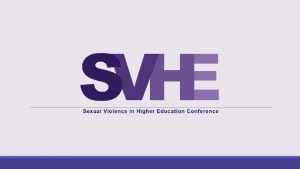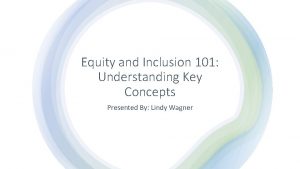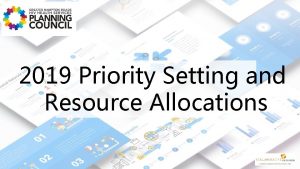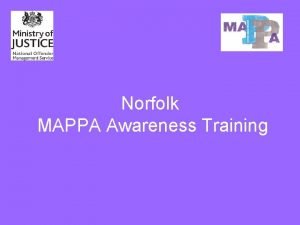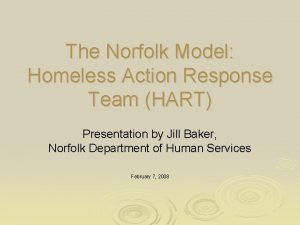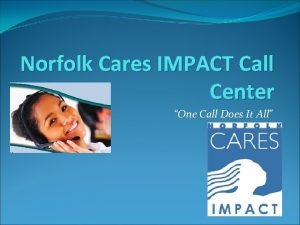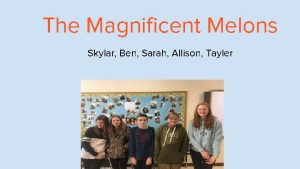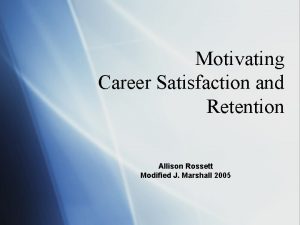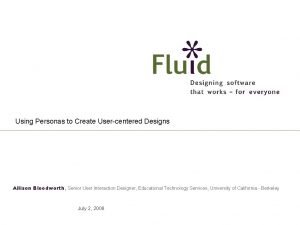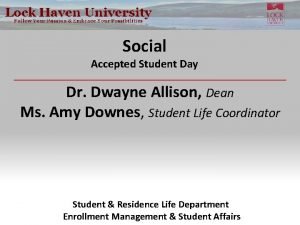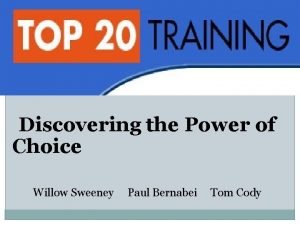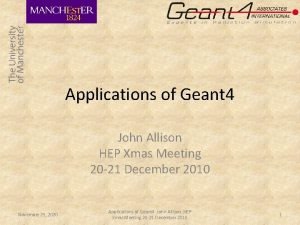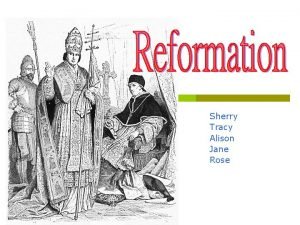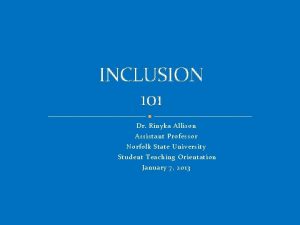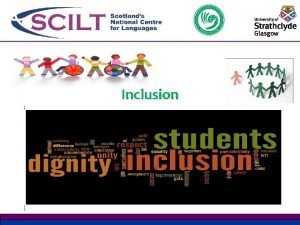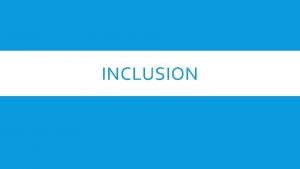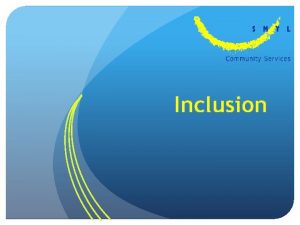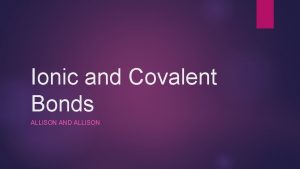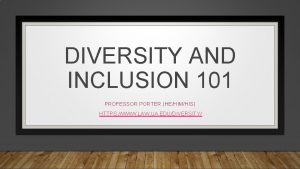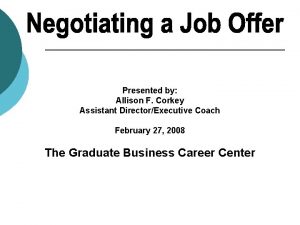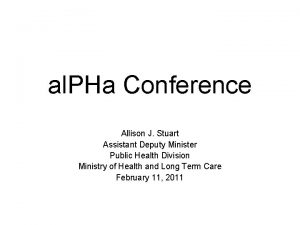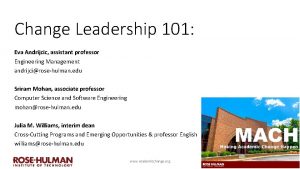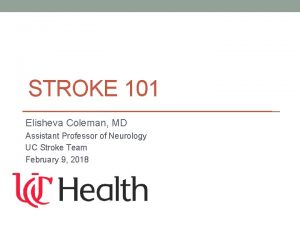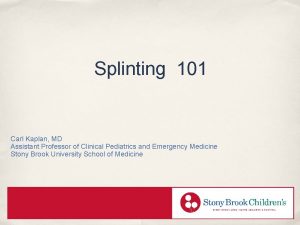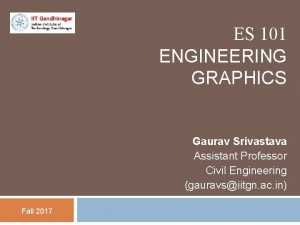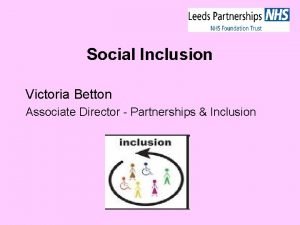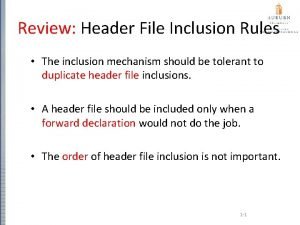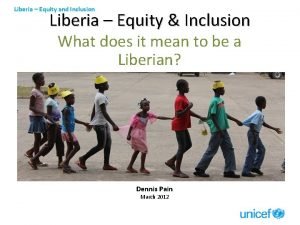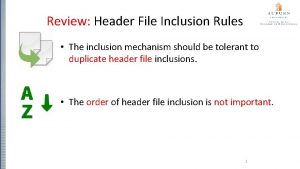INCLUSION 101 Dr Rinyka Allison Assistant Professor Norfolk


























- Slides: 26

INCLUSION 101 Dr. Rinyka Allison Assistant Professor Norfolk State University Student Teaching Orientation January 7, 2013

Objectives Cleary identify the definition of inclusion. Discuss the purpose and logic behind its implementation Discuss current research in regards to teacher’s attitudes and perceptions surround the inclusion phenemon Identify and explore (6) common inclusion models Locate and identify resources that can aid in the effective implementation of inclusion Questions/ Comments

What Is Inclusion? Inclusion: “A set of beliefs based on the idea that students with disabilities have the right to be members of classroom communities with nondisabled peers, whether or not they can meet the traditional expectations of those classrooms” (Friend, 2007, p. 3).

Inclusion: Purpose and Logic The main purpose of inclusion is for students with disabilities to have access to the general education curriculum ( of course given the appropriate accommodations and modifications as outlined in the Individualized Educational Plans ( IEP). Secondly, inclusion allows students with disabilities the opportunity to interact with their non-disabled peers ( academically and socially).

A Little Known Fact � Currently in the United States, over six million students are identified as students with disabilities, which is a 43% increase since 1989 (United States Department of Education, 2006). Of these six million students, 80% are considered to be fully mainstreamed into an inclusion setting. Current research indicates that general educators feel that mainstreaming students with disabilities is a problem because inclusion does not make sense in light of pressures from federal laws such as the No Child Left Behind Act, state legislatures, and the public at large to develop more rigorous academic standards and to improve the academic achievement of all students (Amrein, Berliner & Rideau, 2010). Quantitative research has been conducted on the attitudes and beliefs of general and special education teachers about inclusion and has exposed a lack of understanding of inclusion and how it is approached and applied in the classroom (Monahan, Marino, & Miller, 2001; Shade & Stewart, 2001; Begeny & Martens, 2007). However, few qualitative studies have explored and described the daily lived experiences of both general and special education teachers in the inclusion setting and how those lived experiences may possibly influence their attitudes and beliefs towards inclusion.

Research Study Conducted Dr. Allison The participants for this phenomenological study consisted of four general education and four special education teachers who had taught or were currently teaching in an inclusion setting at one of the 28 elementary schools in the Blessed School District. According to Creswell (1998), criterion sampling works well for phenomenological studies because it is essential for all participants to have experienced the phenomenon that is under investigation.

Research Study Conducted Dr. Allison The criteria used for selecting participants for this study were as follows: (a) a general education or special education teacher who had taught or was currently teaching in an inclusion setting, (b) a general education or special education teacher who was currently teaching at one of the elementary schools in the Blessed School District, (c) a general education or special education teacher who had one or more years of experience teaching in an inclusion setting, and (d) a general education or special education teacher who was licensed as a teacher in the Blessed School District in his or her respective content area. To meet this criterion, the general education teacher must be licensed in elementary education, and the special education teacher must be licensed in special education.

Current Research Conducted by Dr. Allison In this particular study 8 themes were generated related to the participant’s attitudes and beliefs regarding inclusion. a) differing views on inclusion, (b) the perceived roles of teachers in inclusion settings, (c) perceptions of special educators that general education teachers have limited knowledge about special education. (d) experienced implementation of inclusion, (e) differing views about the influence of teaching experiences on attitudes and beliefs about inclusion, (f) experiences of teaching in inclusion setting as a factor that influences the successful implementation of inclusion, (g) the role of experiences of teaching in inclusion and, (h) recommendations for teachers who work in inclusion settings.

Inclusive Education Models

Inclusion Models One teach, One Observe In this model, one individual (generally the stronger of the two teachers in the content or subject being taught) handles all instruction while the other teacher floats or observes the class. This model can be useful when completing student observations for IEPs or Functional Behavioral Analysis (FBA), Pros • • • Cons Minimal coordination • or collaboration is required when planning • Allows the stronger teacher to deliver quality instruction without interruption • Can conceal weaknesses on behalf of a weaker partner in general or on a particular subject Does not fully utilize each instructional specialist Can create a behavior/authority problem for the observing teacher if done regularly Can breed frustration or contempt from the instructional leader if used too often (unless by mutual choice

One Teach-One Assist One Teach, One Assist In this model, one teacher instructs the class while the other teacher manages behavior or assists individual students as needed. Pros Cons Allows a teacher who may • Does not make full use of be instructionally strong to two instructional deliver instruction without specialists interruption • Can establish one teacher as the "bad cop, " resulting in negative feelings toward the behavior manager

Station Teaching (Rotational Teaching) In station teaching, each teacher plans and is responsible for a different aspect of the lesson, or for a different lesson entirely. There may also be independent work provided for the students. Students are divided into two or more groups depending on how many 'stations' are available and either students travel from center to center or students stay in one position and a teacher or work travels to them. Pros • • • Each teacher can independently plan for an area or lesson of strength Each student is exposed to similar material, but groups can be differentiated by level Makes good use of two teachers for management purposes Cons • Requires excellent timing, which can take practice • Requires management of students working independently • May be logistically difficult depending on your classroom space.

Parallel Teaching In parallel teaching, the class is split in half and each teacher takes a half of the class to teach the same lesson. Students all receive the same material. Pros Cons • Provides a smaller group and thus more individual attention • Requires excellent timing, which can take practice • Can provide control for sociallybased behavior problems between students • Requires collaborative planning • Can be difficult to invisibly differentiate in a smaller group • Requires that each teacher be equally strong in the material to be presented

Alternative Teaching In alternative teaching, one teacher teaches the main lesson to a larger group of students while the other teacher works with the smaller group of students on an entirely different lesson. Pros • Provides excellent differentiation opportunities • Provides a chance for remediation or enrichment for students who need it • Can provide behavior control in the smaller group Cons • Must not 'pigeonhole' one group of students by consistently pulling them together • May reduce the efficacy of inclusion by separating students with special needs • May reduce students' exposure to the general education curriculum

Co- Teaching Tag Team (Traditional Co-Teaching) In tag team teaching, both teachers plan and deliver instruction together, with each teacher equally responsible for the material in the lesson. This can be scripted or spontaneous. Pros • Models an excellent respectful working relationship between adults • Allows both teachers to provide perspective on a topic • Can allow teaching of two strategies or ideas simultaneously Promotes respect for both teachers Cons • Requires a rapport that cannot be rushed or faked • Requires meticulous planning together, which can be timeconsuming

A Few Final Thoughts

Dr. Allison’s 4 P’s for Poor Performance in Education Poor Planning yields poor results. Poor results yields poor student achievement. Poor academic achievement yields monetary penalties for schools. Penalties for poor performing schools yields high student drop out rates and profound teacher shortages.

Dr. Allison’s SMILE for Success S- support and equip educators with the proper tools they require to educate all children regardless of their disability. M-monitor students to ensure their academic success and provide them with the necessary interventions and skills needed to compete in a 21 st century economy. I- Include parents, administrations, students and the community in fostering a learning environment that is engaging, rigorous and relevant to the world in which students live. L- Learn to be quick to listen and slow to speak when educating this generation. As educators we too can learn from our students. E. - Every child can learn. As educators it is our responsibility to design and create lessons that allow all children equal access to a FAPE.

Questions ? ? ?

Contact Information Dr. Rinyka Allison Phone: 757 -823 -9109 Email: rballison@nsu. edu

Inclusion Videos Http: //inclusion. com/videos. html http: //www. learnnc. org/lp/editions/every- learner/6692 http: //www. youtube. com/watch? v=Dk. Y 2 D http: //www. youtube. com/watch? v=e 094 Zl. ZA 5 h 8 http: //www. youtube. com/watch? v=l. Qj. Zy 52 e. Y 5 g

References/ Resources Abbott, L. (2006). Northern Ireland head teachers’ perceptions of inclusion. International Journal of Inclusive Education, 10(6), 627 -643. doi: 10. 1080/13603110500274379 Allison, R. ( 2012). The Lived Experiences of General and Special Education Teacher In the Inclusion Classrooms: A Phemenological Study. Canyon Journal of Interdisciplinary Studies 1 (1), 35 -48. Berry, R. (2010). Preservice and early career teachers’ attitudes towards inclusion. instructional accommodations and fairness: Three profiles. Teacher Educator, 45(2), 75 -95. doi: 10. 1080/08878731003623677. Brandes, J. , & Crowson, H. (2009). Predicting dispositions toward inclusion of students with disabilities: the role of conservative ideology and discomfort with disability. Social Psychology of Education, 12(2), 271 -289. doi: 10. 1007/s 11218 -008 -9077 Brandon, D. & Ncube, M. (2006). Botswana’s agriculture teachers’ attitudes toward the inclusion of students with physical disabilities in mainstream classes. The Negro Education Review, 57(3 -4), 215 -227. Breton, W. (2010). Special education paraprofessionals: Perceptions of preservice preparation, supervision, and ongoing developmental training. International Journal of Special

References/ Resources Cook, B. G. , Cameron, D. L. , & Tankersley, M. (2007). Inclusive teachers’ attitudinal ratings of their students with disabilities. The Journal of Special Education, 40, 230 -238. Dixon, S. (2005). Inclusion - not segregation or integration is where a student with special needs belongs. Journal of Educational Thought, 39(1), 33 -53. Glasser, W. (1998). Choice Theory: A new psychological freedom. New York: Harper Collins. Goodman, G. Sullivan, C. (2007). Interventions for increasing the academic engagements of learners (6) with autism spectrum disorder in inclusive classrooms. Teaching Exceptional Children, 39 53 -61. Johnson, B. , & Christensen, L. (2008). Educational Research: Quantitative, Qualitative, Mixed Approaches (3 rd ed. ). Los Angeles, CA : Sage and Keefe, E. B. , & Moore, V. (2004). The challenge of co-teaching in inclusive classrooms at the High school level: What teachers told us. American Secondary Education, 32 (3), 77 -88.

References /Resources Continued Lancaster, J. , & Bain, A. (2007). The design of inclusive education courses and the self-efficacy of pre- service teacher education students. The International Journal of Disability Development and Education, 54(2), 245– 56. Mastropieri, M. , Scruggs, T. , & Berkeley, S. (2007). Peers helping peers. Educational Leadership, 64(5), 54 -58. Retrieved from Education Research Complete database Migyanka, J. , Policastro, C. , & Lui, G. (2005). Using a think-aloud with diverse students: Three primary grade students experience chrysanthemum. Early Childhood Education Journal, 33(3), 171 -177. Pickard, S. (2009). The use of the Welsh inclusion model and its effect on elementary students. Education, 130(2), 265 -270. Retrieved from Education Research Complete database Rheams, T. A. , & Bain, S. K. , (2005). Social interaction interventions in an inclusive era: Attitudes of teachers in early childhood self-contained and inclusive settings. Psychology in the Schools, 42, 53– 63.

References/ Resources Continued Riddell, S. (2009). Social justice, equality and inclusion in Scottish education. Discourse: Studies in the Cultural Politics of Education, 30(3), 283 -296. doi: 10. 1080/015963009030368 Rouse, M. (2007) Enhancing effective inclusive practice: Knowing, doing and believing. Kairaranga. Wellington: New Zealand Ministry of Education. Ryan, D. (2008). An analysis tool for school inclusion for pupils with special educational needs and disabilities. Childcare in Practice. 14 (4) 371 -380. Santoli, S. P. , Sachs, J. , & Romey, E. A. (2008). A successful formula for middle school inclusion: Collaboration, time and administrative support. Research in Middle Level Education, 32(2), 113. Sayeski, K. L. (2009). Defining special educators' tools: The building blocks of effective collaboration. Intervention in School & Clinic, 45(1), 38 -44. doi: 10. 1177/1053451209338398 Scholastic (2013) Blog: Six Models For Collaborative Teaching: http: //blogs. scholastic. com/special_ed/2008/12/six-models-for. html

References / Resources Continued Sharma, U. , Loreman, T. , & Forlin, C. (2007). What concerns pre-service teachers about inclusive education: An international viewpoint. KEDI Journal of Education Policy, 4(2), 95– 114. Siler, S. (2008). A study of the relationship between the mathematics and reading achievement of students with disabilities and inclusive practice in elementary schools. (Doctoral Dissertation, The College of William and Mary, 2008). (Proquest No. AAT 3308116). Subban, P. , & Sharma, U. (2005). Understanding educator attitudes toward the implementation of inclusive education. Disability Studies Quarterly, 25(2), N. PAG. Retrieved from Education Research Complete database. Watnick, B. & Sacks, A. (2006). A snapshot of teacher perceptions on full inclusion in the international urban community: Miami-Dade County, Florida. The Journal of The International Association of Special Education, 7(1), 67 -74. Wedell, K. (2008). Confusion about inclusion: patching up or system change? British Journal of Special Education, 35(3), 127 -135. doi: 10. 1111/j. 1467 -8578. 2008. 00386. x
 Robert allison sexual assault
Robert allison sexual assault Promotion from assistant to associate professor
Promotion from assistant to associate professor Fok ping kwan
Fok ping kwan Diversity equity and inclusion 101
Diversity equity and inclusion 101 Cstd gateshead
Cstd gateshead Norfolk gazette
Norfolk gazette Awg warehouse locations
Awg warehouse locations Tga norfolk
Tga norfolk Norfolk mappa
Norfolk mappa Hart team norfolk
Hart team norfolk Norfolk cares hotline
Norfolk cares hotline Awg appointment scheduling
Awg appointment scheduling Norfolk constructing excellence
Norfolk constructing excellence Alisson tayler
Alisson tayler Allison morgan ts
Allison morgan ts Allison rossett
Allison rossett Dr allison clarke
Dr allison clarke Allison
Allison Allison keegan
Allison keegan Allison cowie
Allison cowie Well ordering principle
Well ordering principle Allison bloodworth
Allison bloodworth Kohl's organizational chart
Kohl's organizational chart Now allison dean
Now allison dean Allison sweeney bio
Allison sweeney bio Allison gauss
Allison gauss Tracy allison mediation
Tracy allison mediation
